Load development is a very personal and sometimes even a controversial thing. Precision-minded shooters tend to adopt their own “obsessive” or “religious” rituals when it comes to finding the perfect load for their rifles. I like to read up and watch up (is that a term?) on what other people are doing for load development as “inspiration”. But at the end of the day I believe each shooter has to find for themselves what will work best for their equipment, goals, and needs. I also like to try and show different things here on Ultimate Reloader, otherwise it’s just the same thing over and over. So when it came time to find an optimal 70 grain load for the 224 Valkyrie AR-15 I just built, I thought I would try something different.
Gavin’s Typical Load Development Approach
*Note: when I’m talking about load development in this article, I’m really only focusing on powder charge weight. There are many other factors including primer type, bullet type, bullet seating depth, and other factors that can be equally important. A thorough discussion of load development in its entirety is beyond the scope of this article and video. Some or all of the processes I talk about below have to be repeated when other load factors are changed.
Although continually evolving, my current approach to load development (and research) is as follows:
- Define the problem domain: The rifle and chambering (with related specifications such as barrel length and twist rate), and selection of components- typically the bullet that will be used.
- Read and review load data and related information online, and in loading manuals. Nosler will indicate which loads were most accurate for the load data they publish online, which is very helpful.
- Pick a load (minus charge weight). Determine which brass, primer, powder and bullet will be used.
- Determine the charge weight range of interest. This could be starting at min load and working up to max load, or could involve a more narrow charge weight range. Ron Reiber (Hodgdon chief ballistician) has advised me that accurate and consistent loads will most often occur at near max loads. More specifically, at just over or under the point where the load becomes compressed (if applicable).
- Run a 10-shot load development test
- Run OCW tests based on speed nodes from 10-shot testing
10-Shot Load Development
The idea with 10 shot load development is to shoot different charge weights in order to find “speed nodes” which represent stable charge weight regions. What does this mean? If you’re in a “speed node”- you can make slight changes to charge weight without changing velocity much. This is of tremendous importance once you get to really long ranges like 1000 yards, and beyond.
From a story I published on “Expanded 10-shot load development”, the following graph shows the relationship between speed nodes and velocity stability (expressed as SD of velocity):
Once I’ve identified “speed nodes” – I move on to Optimal Charge Weight testing…
Optimal Charge Weight (OCW) Testing
OCW testing is pretty straight forward- you load batches of ammunition where each batch increments the charge weight by a value you calculate based on the weight range you want to cover. You then shoot each batch of ammunition (I load and shoot in batches of 5) and look at the group size for each batch of ammunition. The idea is that you can identify loads that shoot well based on the particulars of your rifle. This testing will not typically focus on velocity consistency (SD of FPS)- it’s really about what charge weights shoot well in your rifle at 100 or perhaps 200 yards.
The 6.5 Guys have put together a series on load development, and here’s one of the OCW tests from that series:
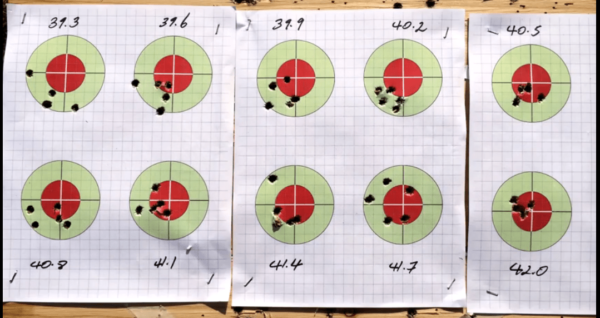
Photo credit: http://65guys.com
You can see from the picture above that 42.0 grains was a load that worked well in the rifle being tested. My personal approach with OCW is to test speed nodes from the 10-shot analysis to see how they will group. And that leads me to my “hybrid approach”.
Test: Hybrid Approach
When working up a load, you always have some information- sometimes more, sometimes less. In this case, I had a load that I knew shot really well in the Remington 700 Bolt-Action rifle I had built. Would it shoot well in the AR-15? I decided to do the following:
- Work up to 25.5 grains of Varget- the load that had worked so well in the Remington 700
- Create four batches of ammunition, with 0.5 grains reduction in each group below the 25.5 grain load
- Shoot OCW-style groups for each batch of ammunition
- Record velocity information to see if small groups and low SD numbers would coincide
Here’s the load that I started with from the Remington 700 barrel break-in:
- Starline 224 Valkyrie cases (new)
- Federal 205 small rifle primers
- 25.5 grains Hodgdon Varget (25.8)
- 70 grain Nosler RDF bullets
Use load data at your own risk. Ultimate Reloader is not responsible for errors in load data on this website. Always cross-reference load data with manufacturer’s published data.
And here are the results for each charge weight tested:
24.0 Grains Varget
24.5 Grains Varget
25.0 Grains Varget
25.5 Grains Varget
Data Summary
| Grains Varget | Velocity (AVG) | Velocity (SD) | Group Size |
| 24.0 | 2715.0 | 19.8 | .716″ |
| 24.5 | 2750.0 | 18.5 | .869″ |
| 25.0 | 2844.0 | 16.8 | .514″ |
| 25.5 | 2905.0 | 7.0 | .595″ |
Pick A Winner
If I had been entirely “data driven” and literal with my OCW, I would have had pause about target #4. With a group size larger than target #3, OCW alone would have made me think the 25.0 grain charge weight could be the best with this rifle. However, when I examined the three cloverleaf shots in group #4, I thought- I bet that group size increase was partly due to me: the shooter. So I decided to shoot some groups with the #4 load (25.5 grains of Varget, the same load that worked well in the Remington 700) to see if I could tighten things up. And I did!
Here’s the unedited video showing the shooting of this group:
Now things are looking good- with an SD of 7.0 FPS, and a group size of 0.500″, this load met my goals, and for both rifles no less! So in the end, this was really a “load validation” rather than a true from-scratch load development exercise. I had some data from the Remington 700 to go off of, and I used that and my “hybrid approach” to validate that this load was truly optimal for the AR-15. Mission accomplished.
As it turns out, both of the rifles I built with Benchmark match-grade barrels are capable of approximately 0.3 MOA performance as I recently showed recapping my 600 yard range day:
224 Valkyrie at 600 Yards: Bolt -vs- AR with Unexpected Results
In context, this was just my first test bullet- the Nosler 70 grain RDF, a great shooter. However- the 224 Valkyrie really shines when you get into the heavier high-BC bullets, and that will be my next focus. I now know it’s possible to find a load that works well in both rifles, and I’m hoping that will be true for the Hornady 88 grain ELD-M bullets, as well as the Sierra 90 grain Match Kings. We’ll see! Make sure you’re subscribed to find out what happens next.
Do you have 224 Valkyrie reloading or general load development insights you’d like to share? Please leave a comment!
Thanks,
Gavin
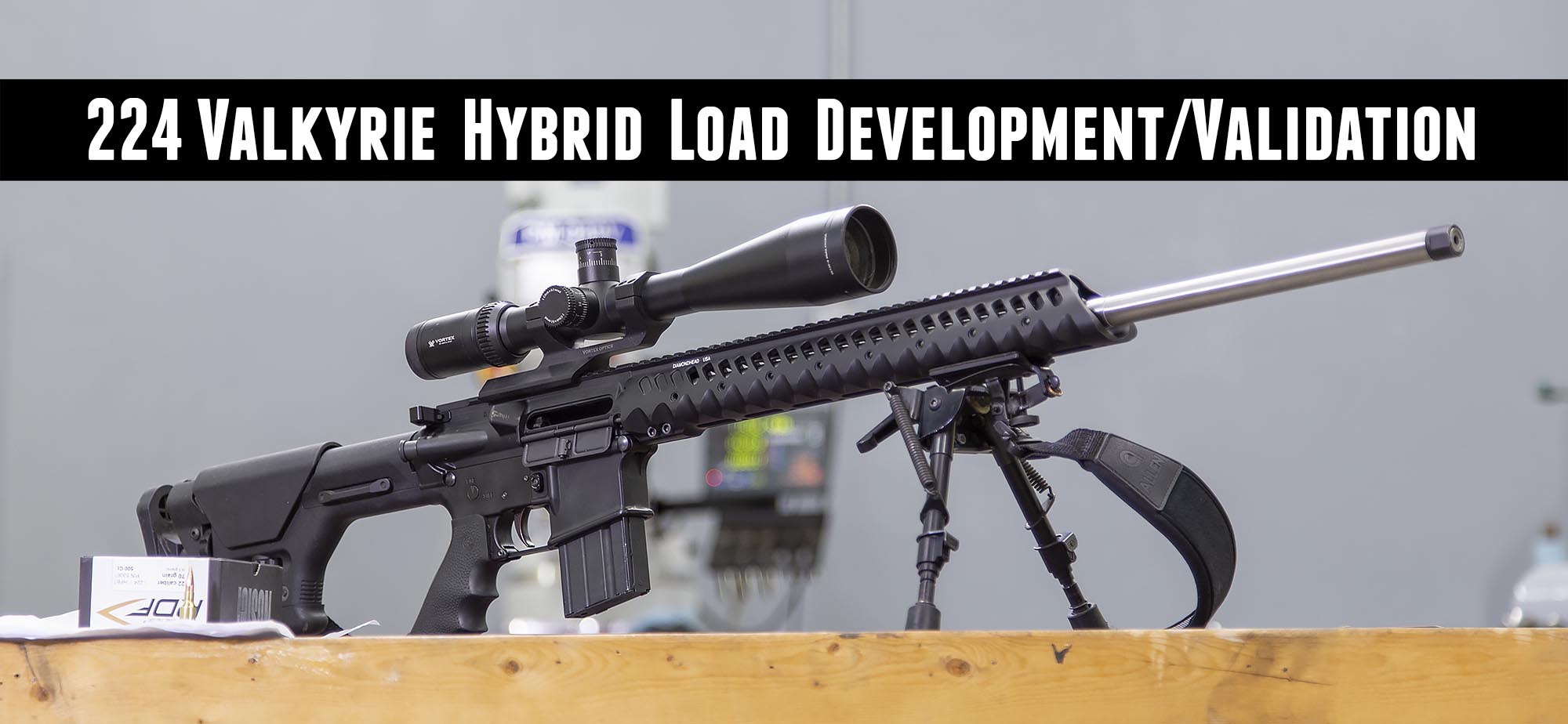
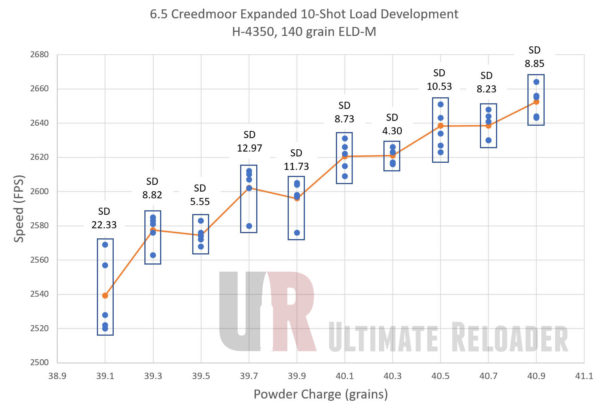
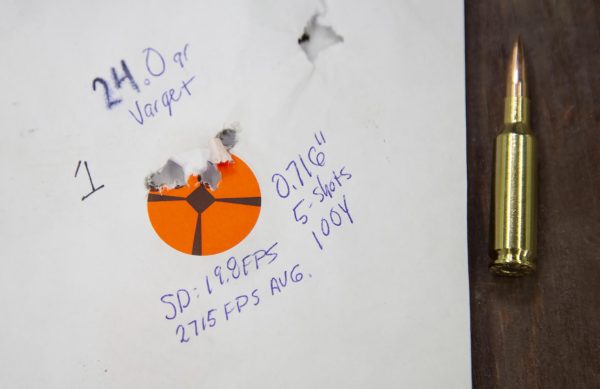
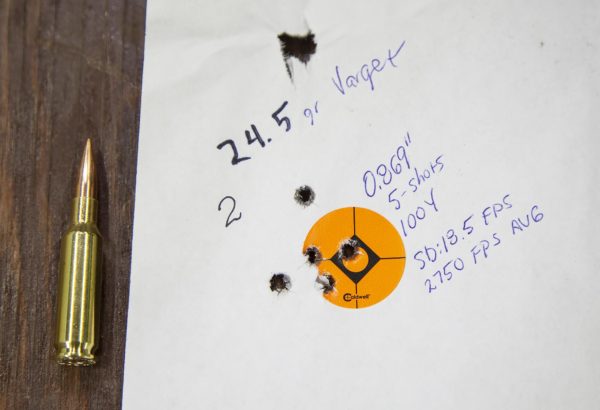
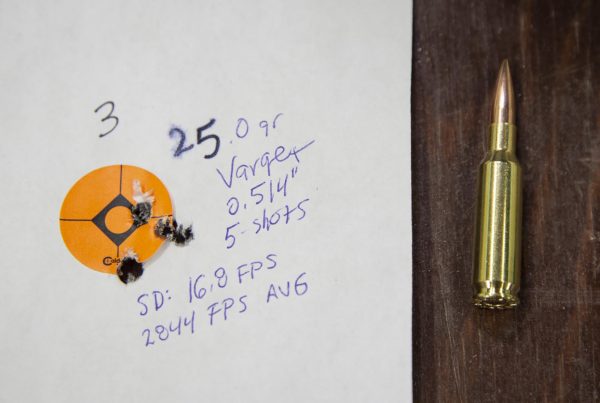
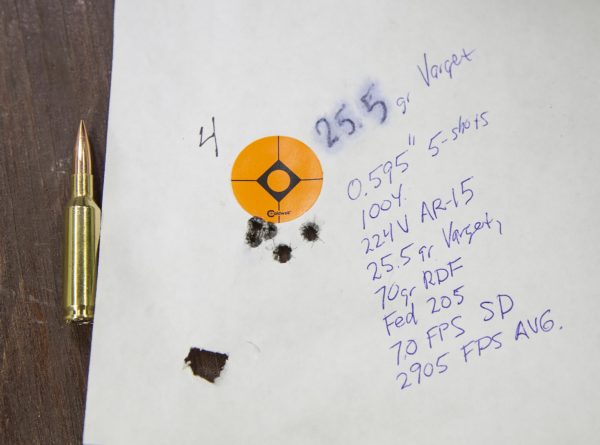
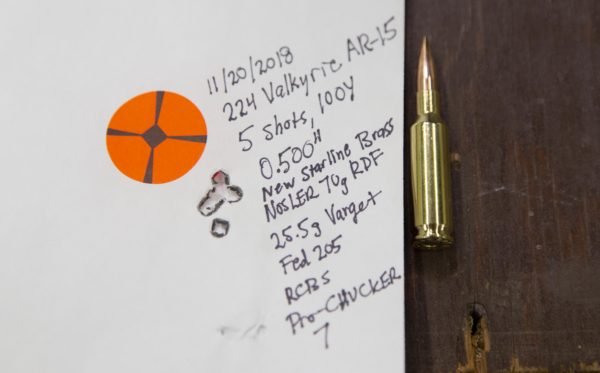


















































































Really good article. I just ordered a complete 24″ barreled Valkyrie upper after reading this.
Awesome, and thanks! What upper did you go with?
Hey Gavin,
Do you know of any load data using gas checked cast lead bullets
for the 6.5mm Grendel ? The rifle is a Howa M1500 Mini Action. Thanks
for your time, effort and great videos,
Best Regards,
Glenn Zeigler
Fabulous work! You are one of the only ones I know of who are putting the 224 Valkyrie through a systematic load development. Well done! I look forward to data on heavier bullets.
Great article and videos. I’m just starting out with my Columbia River Arms 24in Valkyrie. So far the factory load results have been abysmal. I’m currently shopping for dies and I’m leaning towards the Redding deluxe set (with the micrometer seating die). Which dies did you use for this project?
Whoops, please disregard my previous question and post…. A little “digging” on your page and I see that you are running RCBS dies.
Thanks for sharing your work and findings!
Where can I find the build article on the AR-15 224?